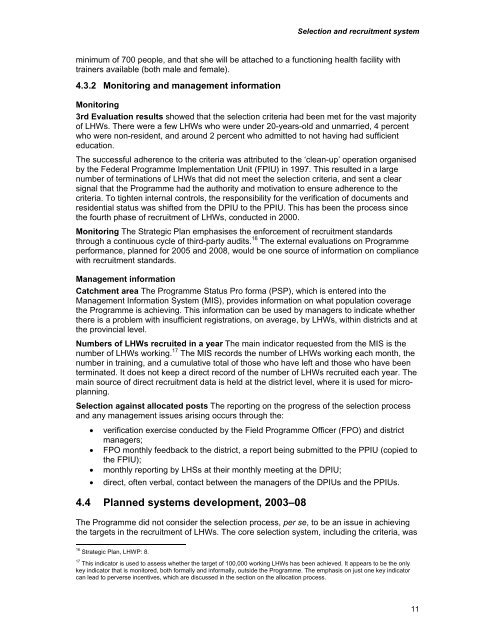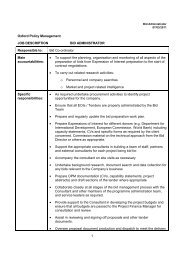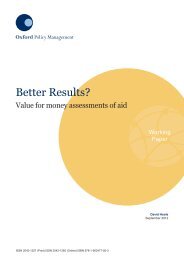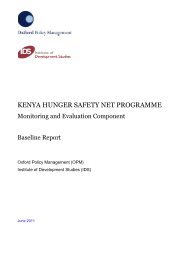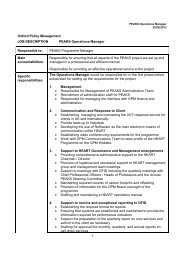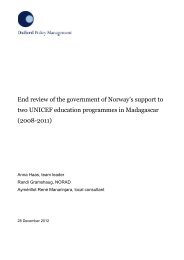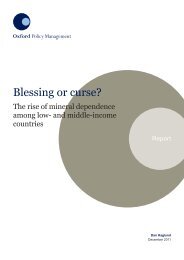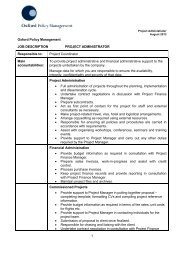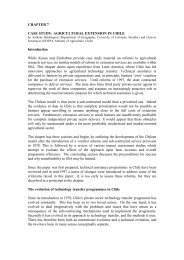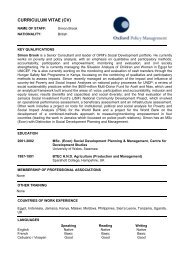LHW Systems Review - Oxford Policy Management
LHW Systems Review - Oxford Policy Management
LHW Systems Review - Oxford Policy Management
You also want an ePaper? Increase the reach of your titles
YUMPU automatically turns print PDFs into web optimized ePapers that Google loves.
Selection and recruitment systemminimum of 700 people, and that she will be attached to a functioning health facility withtrainers available (both male and female).4.3.2 Monitoring and management informationMonitoring3rd Evaluation results showed that the selection criteria had been met for the vast majorityof <strong>LHW</strong>s. There were a few <strong>LHW</strong>s who were under 20-years-old and unmarried, 4 percentwho were non-resident, and around 2 percent who admitted to not having had sufficienteducation.The successful adherence to the criteria was attributed to the ‘clean-up’ operation organisedby the Federal Programme Implementation Unit (FPIU) in 1997. This resulted in a largenumber of terminations of <strong>LHW</strong>s that did not meet the selection criteria, and sent a clearsignal that the Programme had the authority and motivation to ensure adherence to thecriteria. To tighten internal controls, the responsibility for the verification of documents andresidential status was shifted from the DPIU to the PPIU. This has been the process sincethe fourth phase of recruitment of <strong>LHW</strong>s, conducted in 2000.Monitoring The Strategic Plan emphasises the enforcement of recruitment standardsthrough a continuous cycle of third-party audits. 16 The external evaluations on Programmeperformance, planned for 2005 and 2008, would be one source of information on compliancewith recruitment standards.<strong>Management</strong> informationCatchment area The Programme Status Pro forma (PSP), which is entered into the<strong>Management</strong> Information System (MIS), provides information on what population coveragethe Programme is achieving. This information can be used by managers to indicate whetherthere is a problem with insufficient registrations, on average, by <strong>LHW</strong>s, within districts and atthe provincial level.Numbers of <strong>LHW</strong>s recruited in a year The main indicator requested from the MIS is thenumber of <strong>LHW</strong>s working. 17 The MIS records the number of <strong>LHW</strong>s working each month, thenumber in training, and a cumulative total of those who have left and those who have beenterminated. It does not keep a direct record of the number of <strong>LHW</strong>s recruited each year. Themain source of direct recruitment data is held at the district level, where it is used for microplanning.Selection against allocated posts The reporting on the progress of the selection processand any management issues arising occurs through the:• verification exercise conducted by the Field Programme Officer (FPO) and districtmanagers;• FPO monthly feedback to the district, a report being submitted to the PPIU (copied tothe FPIU);• monthly reporting by LHSs at their monthly meeting at the DPIU;• direct, often verbal, contact between the managers of the DPIUs and the PPIUs.4.4 Planned systems development, 2003–08The Programme did not consider the selection process, per se, to be an issue in achievingthe targets in the recruitment of <strong>LHW</strong>s. The core selection system, including the criteria, was16Strategic Plan, <strong>LHW</strong>P: 8.17This indicator is used to assess whether the target of 100,000 working <strong>LHW</strong>s has been achieved. It appears to be the onlykey indicator that is monitored, both formally and informally, outside the Programme. The emphasis on just one key indicatorcan lead to perverse incentives, which are discussed in the section on the allocation process.11


